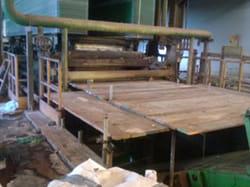Metal Cutting Band Saw Blades
In the manufacturing and industrial sectors, these cutting blades serve as a foundation upon which they can enable accuracy at various levels and increase efficiencies in metalworking tasks. It is important to learn about some of these blade types, their kind of materials as well and how to maintain them so that you can operate at optimal levels whenever you wish to use any of them in metals such as aluminum, steel, and stainless among others; whether in metal fabrication or construction or whatever other sector where precise cuts are required.
These specialized band saw blades with metal cutting functions are meant to work on various kinds of metals namely steel, aluminum, or stainless steel. Unlike ordinary saw blades which may not be suitable for aluminum or metals in general, these specialized ones have special attributes that allow them to perform better than other types when working with harder materials.
A continuous steel band with teeth is what makes these blades. A band saw machine has two wheels which the steel band runs around as it moves perpetually. Their efficient cutting process is attributed to their capability of making consistent clean cuts thus minimizing the wastage of materials.
Band Saw Blades Designed for Metal Cutting
To meet the various demands of the metalworking process, there are many types of metal cutting band saw blades that include:
Bi-Metal Blades: They have a high-speed steel edge fused onto a flexible spring steel back. Therefore, they are both hard and soft to last long and serve different purposes. They suit cutting a wide range of metals including tough alloys.
Blades with carbide tips: They are extremely tough and have tooth tips made from carbide material making them wear-proof forever. They are the best for cutting industries dealing with tough substances like stainless steel and titanium; furthermore, their frequency of sharpening is lower hence higher productivity rates can be achieved.
High-Speed Steel (HSS) Blades: All these blades are made from high-speed steel which makes them able to cut well without getting hot quickly. They work best on soft metals, requiring precision cuts.
Alloy Steel Blades: Made from alloyed steels this type of blade is recommended for general use on metal cutting. They are widely used owing to the good compromise they provide between performance and price.
Blades Made of Innovative Materials Boosting Performance
The metal cutting band saw blade performance has been greatly improved by recent developments in blade materials. Bi-metal blades are a popular choice among contemporary cutting processes and feature high-speed steel edges fused with flexible spring steel backs. Thus providing the necessary hardness for tough metals’ cuts while still being flexible enough to absorb shocks and reduce breaking incidences.
Carbide-tipped Japanese saws also make use of carbide-tipped teeth that give them amazing durability and hence can serve as ideal tools for cutting high-strength alloys or even stainless steels. Such innovations have made it possible to produce metal cutting band saw blades capable of handling various materials and cutting conditions thus leading to more efficiency while at the same time reducing costs incurred during industrial operations.
Applications and Industry Trends
In many sectors, for example, automotive, aerospace, and construction, metal cutting band saw blades are widely applicable. Contemporary blades provide superior performance and longer life span due to advancements in materials and also due to technological innovations. Such trends as employing high-performance coatings and creating uniquely shaped blades have been stretching the limits of these instruments.
Essential Practices in Maintenance That Guarantee Longevity
For metal cutting band saw blades, regular inspection to identify any signs of wear like dull or chipped teeth, is necessary for their durability and stable operation. It also prevents sudden breakdowns and ensures perfect cuts by avoiding blunted edges due to inappropriate tensioning done on the blade while it is installed on the band saw machine; otherwise, this might result in poor cutting outcomes as well as parts getting worn out without justifiable cause.
One more significant practice is keeping clean all parts around the blade including cutting area from metal scraps or coolant residues which may interfere with cutting efficiency or reduce the life span of blades. The appropriate choice of cutting fluids or lubricants minimizes the friction that causes heat, thereby enhancing the longevity of these tools while at the same time enabling efficient cutting action.
To Wrap Things Up
In fabrication and manufacturing, the use of metal cutting band saw blades ensures precision and effectiveness. Different types of blades such as bi-metal, carbide tipped, high-speed steel, and alloy steels are comprehended by professionals to maximally perform their jobs as well as extend the lifespan of these tools. The development in blade materials and designs has improved durability and cutting efficacy substantially in line with the contemporary demands of metalworking.
Proper maintenance of these blades alongside an awareness of industry trends is essential for tapping the maximum benefits they offer. This is often achieved through regular checks, right tensioning; and keeping the cutting area free from debris to minimize premature wearing out and guarantee even cuts at all times. Following this good practice would also involve having an understanding of recent technologies that would lead to more productivity as well as cost reduction in metalworking.






Comments